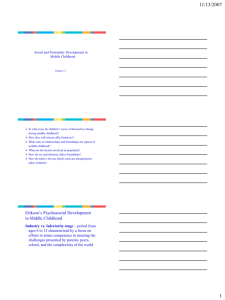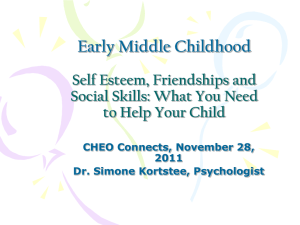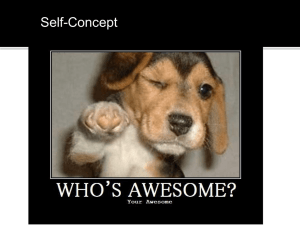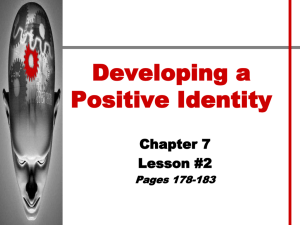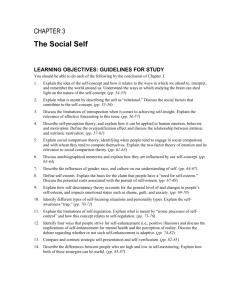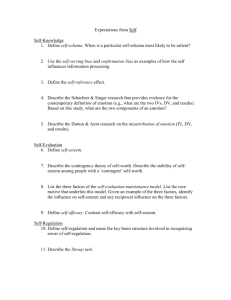EMOTIONAL AND SOCIAL DEVELOPMENT IN MIDDLE CHILDHOOD
advertisement
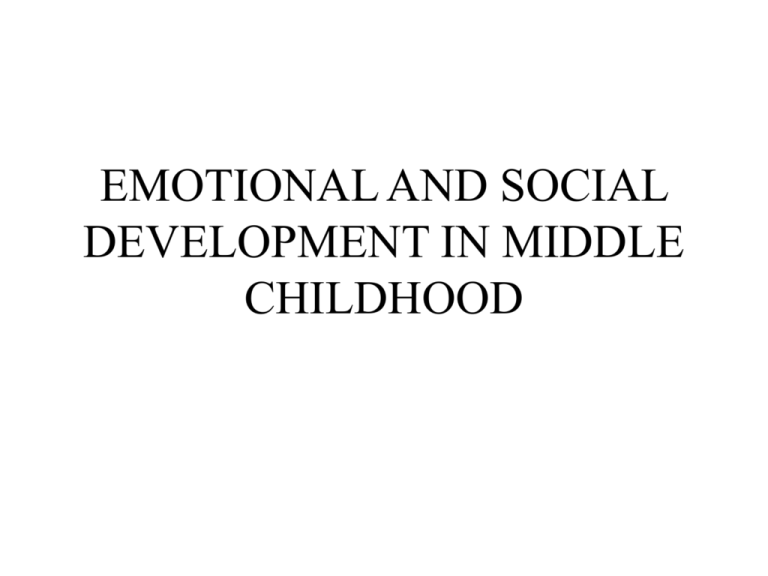
EMOTIONAL AND SOCIAL DEVELOPMENT IN MIDDLE CHILDHOOD Basic Premise Associated With Psycho-social Development • Personality development is determined by stress which is caused by social factors in consort with innate biological predispositions. • It is both the individual’s life experiences and his internal crisis which acts as a catylist to personality outcomes. Erikson’s Psychosocial Model • Internal crises which must have resolution to facilitate healthy personality development – – – – – – – – Trust vs. Mistrust Autonomy vs. Shame/Doubt Initiative vs. Guilt Industry vs. Inferiority Identity vs. Confusion Intimacy vs. Isolation Generativity vs. Stagnation Integrity vs. Despair • Quality of resolution may be related to quality of personality development PSYCHOSOCIAL DEVELOPMENT • Erikson’s Industry vs. Inferiority – According to Erikson, a combination of adult expectations and children’s drive towards mastery creates the crisis in this stage. – Formal schooling and socialization. Children are learning roles and talents. Self-Development/Middle Childhood • Changes in self concept occur between ages 8 – 11. Children begin to: – Describe self in psychological traits – Compare self to peers (social comparisons) – Speculate about their strength and weaknesses • C. H. Cooley—Looking Glass Concept Self Development in M. Childhood • Children increase in the development of perspective taking. • Between ages 8 and 15, children start to depend more on peers for feedback. However, parents continue to remain influential. • Development of self varies across cultures. – In US, we promote independence and uniqueness. Self is defined from the individual. – Asian parents promote harmonious interdependence. Self is defined from the social group. Development of Self-Esteem • Self-esteem refers to judgments children make about their own worth. • Self-esteem generally declines in Middle Childhood due to increased feedback from peers and school. • According to Harter (1982), Self-Esteem can be observed as: – Academic – Social – Physical Influences on Self-Esteem • With high self-esteem, children work harder in school and artistic expression. They generally display greater prosocial behaviors. • Culture plays an influential role in self-esteem development. – Asian children tend to have lower self-esteem than US children. • Parenting styles also influence self-esteem development. – Which parenting style is most effective towards self-esteem development? – Does optimal parenting style vary as a function of culture? Self Concept and Attributions • Attributions are our common, everyday explanations for the causes of behavior. • Children with high self-esteem develop demonstrate mastery attributions: – mastery-oriented attributions. Attributions that credit success to high ability and failure to insufficient efforts. – Learned helplessness attributions. Attributions that credit success to luck or failure to low ability. Emotional Development • Key develops: – Empathy. During middle childhood, children develop a sensitivity to the feelings of others. – Emotional Self-Regulation. The ability to manage negative emotions that threaten self development. Coping and problem-solving increases during this period. • Girls with poor self-regulation tend to freeze with anxiety. • Boys with poor self-regulation tend to lash out with hostility. • Children raised in institutions tend to have poor self-regulation. Development of Competence in Middle Childhood • Adjusting in School. – This becomes the 1st real test of social preparedness for middle schoolers. Key determinate for social integration. • Establishing Peer Relationships. – The quality of peer/friend alliances become a key marker for later adaptation in society. • Learning to play by the rules. – Rule-abiding as opposed to rule-breaking often predicts social and academic competence over the next decade. • Achieving Academically. – The ability to perform academically affects children’s perception of self and consequently contribute to efforts toward performance. Relationship Development During Middle Childhood • Parent/Child Relationships – Children spend about 50% less time with their parents than their preschool years – Family support remains important as children practice their developing skills in society – Optimal development occurs when parents employ structured autonomy. Quality relationship (Authoritative) is correlated with • • • • • academic performance (positive) peer relationships (positive) befriending of delinquent peers (lower) Aggression (lower) conflict in the classroom (lower) • Because children model, parents teach competence through their actions Family Constellations Among Middle Schoolers • Over 50% of children born in 1990s experienced divorcing parents. – African-American children are at a higher risk (Why?) – African-American children are at greater risk to becoming single parents (Why?) – Both African-American and Hispanic families are less likely to remarry after divorce • 50% of children of divorce can expect to have step fathers within 4 years. Family Constellations Among Middle Schoolers, Cont. • Most single parent families lack fathers • Some studies show: – Greater atmosphere of warmth – Increased mother interaction with children – More secure mother/child attachments • On the other hand: – These children tend to grow up feeling less cognitively and physically competent Family Constellation Cont. • Factors Associated With Divorce and Child Outcomes – Quality of Interaction • A vast majority of children of divorce adjust well to the changing family arrangement • Quality of parenting is more important than family arrangement – Developmental Stage • Preschoolers tend to display greater adjustment problems than middle schoolers (Why?) • Remarriage is more likely to have a lasting psychological impact on pre-adolescents (Why?) – Gender • Boys tend to have a more difficult time adjusting to divorce in middle school (Why?) • Boys are more likely to act out or externalize overtly. Girls are more likely to act out internally (i.e., engaging in self-blame, depression) Thought Process Implosion Implosion Theory • The child is experiencing rapid changes both internal and external • In part, internal changes are in response to external changes; external changes are in response to internal changes. • While trying to achieve a balance, what happens when the internal factors are depleted or diminished? What of my character? What of my motivation to thrive?
